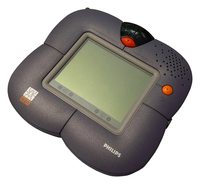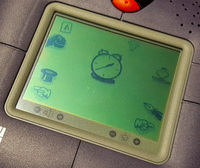Philips in2It
| Home > Browse Our Collection > Computers > Philips > Philips in2It |
|
A product of Philips ‘Kidcom’ project, the In2it is an unreleased PDA & handheld gaming device aimed at girls aged 8-12. The name is stylised as "in2iT" on the system itself, but varies in print. It was an odd time for Philips to choose to develop a console in the unfamiliar market of “for girls”, given the decline of their CD-i, and Casio’s recent ‘girl’s console’ commercial failure, the Loopy, the year prior. Both of these factors probably led to the cancellation of the In2it in December 1996. It never reached commercial release. Allegedly some of the estimated 100-1000 units produced were sent to media for review, and some sources say some were distributed to schools. Most of the remaining units were said to be sold internally. It has a black & white touch screen, stylus, external speaker, and infrared capability. It is quite bulky for a PDA, and does not have a backlight. It runs on 4 x AA batteries, and has a 6V DC power supply socket. It also has a CR-2032 backup battery. It was produced in Hungary. It has volume and contrast adjustments on the front as part of the touch screen, and a home screen and an infra red button near the receiver. It has a power on/off button at the side (though this is just a sleep mode so it can still receive IR data), and a reset button at the back. The stylus is kept in the left side of the system - very unusual for PDAs, but very welcome for the left-handed user. The primary chip used was an obscure one sourced from Taiwan, but stocks were running low and ceased being produced, dooming the system. Working around a replacement chipset could take around a year, and contributed to the product being cancelled before it even hit the shelves. The software came on chipped ‘smart cards’ which were to be sold in jewel cases when not bundled with the system. There were a total of 16 pieces of software produced split into categories, including: Basics, Style, Discovery, Sports & Hobbies, Specials, Music Info, You, and Film/TV. Titles within these included the typical kinds of female-aimed fare: astrology, horses, and a Boyzone fact file… Although the system didn’t reach commercial release, there was already a promotional card produced for ‘Oillily’, a women & children’s clothing brand, which allowed you to see upcoming fashion! Within the Basics category there were also ‘box cards’, in which you could store your letters and other files to save room on the system, and ‘key cards’, which enabled password locking. It seems the device would have come bundled with at least one box card and a key card, but unfortunately these are not present with our example. Without a card in the device it has an alarm clock, calculator, matchmaker, fortune teller, address book, greetings card maker (in which you can send it via infrared to a friend’s system), letter writer, sketchbook, and tune maker. The home screen features some animals which also have functions, detailed in the manual. The bunny in the magic hat allows you to copy files, Rex the dinosaur acts as a trash bin by “eating” your unwanted files, and Carey the bird sends your messages to other nearbyIn2it owners and brings back replies, too. There are also some animations of rabbits, and a sun, that float around the menu screens idly like desktop pets. It was product-tested by girls in international schools in the Netherlands. Six units were loaned to the Department of Computer Science and Engineering at Helsinki University of Technology (via contacts at the Netherlands Design Institute) by Philips, as part of research conducted to learn what young people do to pass time. A consecutive study was also run, but using the Game Boy camera device instead, when they decided they wanted to focus down on how children interacted with digital imaging specifically. The children were given the devices and manuals, and were invited back a week later to return them and discuss them. They were asked to give suggestions for ways to improve the devices. This is not to be confused with the above mentioned product testing which took place in the Netherlands - these suggestions were not intended to be used to improve the devices, but were asked for as part of the study, intending to reveal something about the children’s preferences in general. A conclusion of the study was “fun is doing it together” in that the interactivity with other people and systems was the most enjoyable feature. The full findings can be read here. Werner Marinelli, who worked on the In2it project later said they were pleased to see the success of the Tamagotchi (released in Japan just a month prior to in2it cancellation), which had much in common with the In2it in this respect. From September 2021 - January 2022, there is an exhibition dedicated to the in2it at Bonami SpelComputer Museum in Zwolle. It is as yet unconfirmed if it will still be running after the current lockdown there. Manufacturer: Philips Comment on This Page Other Systems Related To Philips in2It:
This exhibit has a reference ID of CH66854. Please quote this reference ID in any communication with the Centre for Computing History. |
Click on the Image(s) For Detail
|














